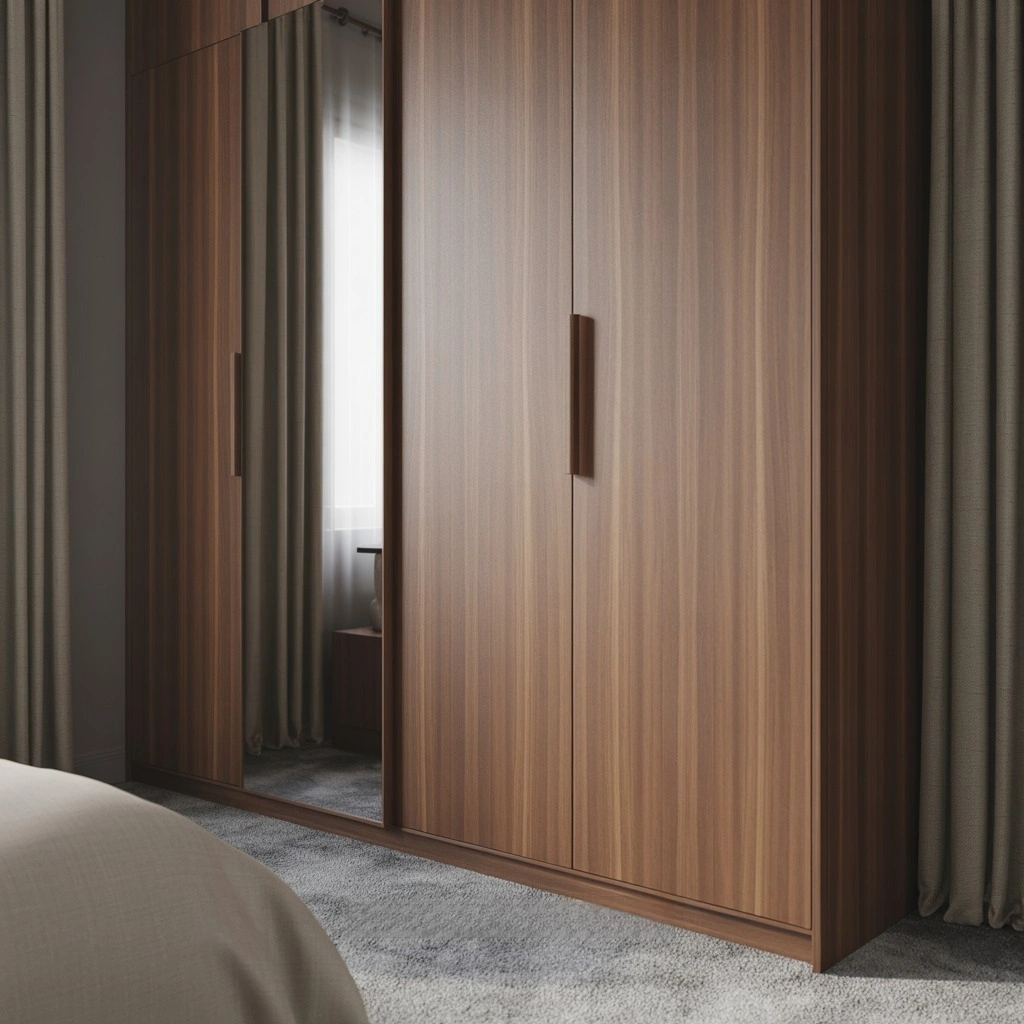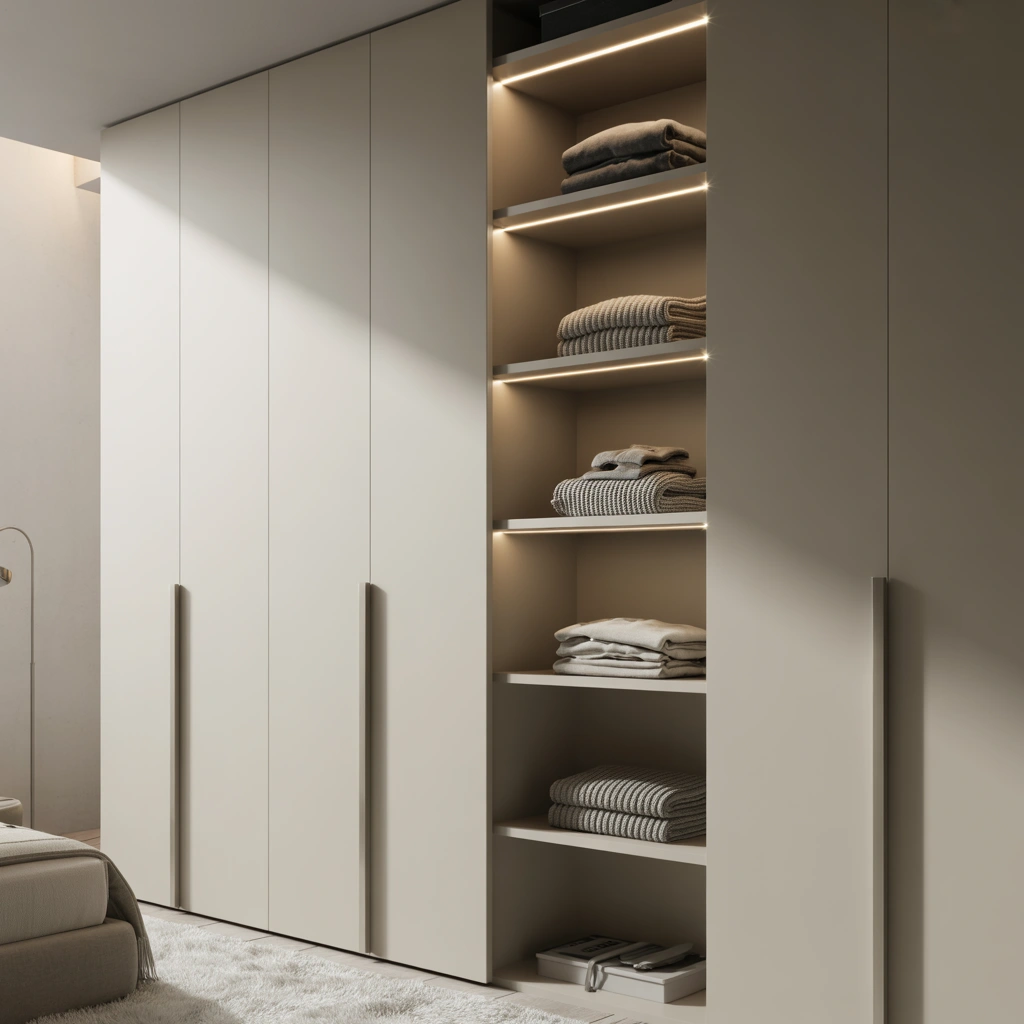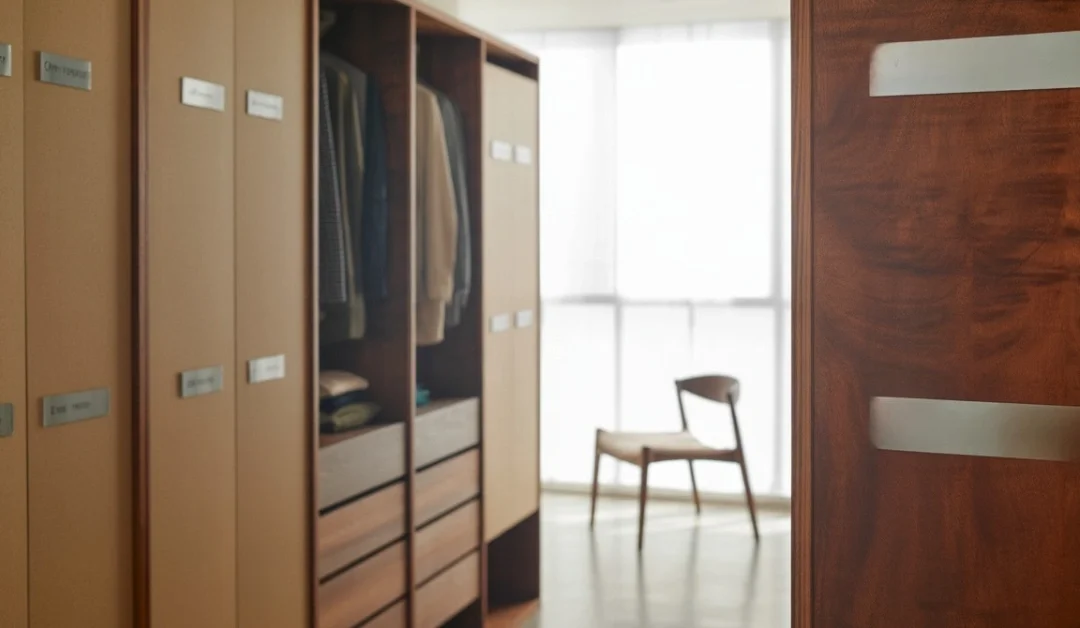Wardrobes are not just storage boxes—they’re long-term investments. The material used to build them decides how long they last, how well they protect your clothes, and how good they look in your room.
If the wrong material is chosen, termites might eat through the wood, humidity could warp the structure, or the color might fade in a few months. By picking the right materials, you avoid these problems and get a wardrobe that’s termite-proof, durable, and stylish for years.
For example, a wardrobe made of untreated MDF (Medium Density Fiberboard) might swell in a rainy season. But if it’s coated with HPL (High-Pressure Laminate), it becomes waterproof and scratch-resistant.
1. What Are the Top 7 Termite-Proof & Durable Materials for Wardrobes?

1. Is Marine Plywood a Good Option for Termite-Proof Wardrobes?
Marine plywood is made by gluing layers of wood together with waterproof adhesive. It’s baked under high pressure, making it dense and hard for termites to chew. It’s also a great choice for building Custom Wardrobe Designs to Maximize Your Storage Space.
- Why it’s great: Waterproof, strong, and lasts 15+ years.
- Best for: Bathrooms, kitchens, or humid areas.
- Cost: Mid-range (₹1,200–₹2,500 per sheet in India).
Marine plywood is often used in boats, so it’s no surprise that it resists moisture and pests. However, it’s heavy, so it needs strong brackets if mounted on walls.
2. Why Choose HDHMR Boards for Humid Climates?
High-Density High Moisture Resistance (HDHMR) boards are engineered to fight dampness. They’re treated with chemicals that repel water and termites.
- Why it’s great: Won’t swell in monsoon seasons.
- Best for: Coastal regions or rainy climates.
- Cost: Slightly pricier than regular MDF.
HDHMR boards come pre-laminated, so they don’t need extra coatings. They’re also eco-friendly, as they use less formaldehyde.
3. Do HPL Panels Offer Style and Protection?
HPL (High-Pressure Laminate) panels are made by pressing layers of paper and resin under heat. The result is a tough, glossy surface that resists scratches, UV rays, and pests.
- Why it’s great: Over 100 finishes available (wood grain, marble, metal).
- Best for: Modern, minimalist designs.
- Cost: ₹800–₹1,500 per sq. ft.
HPL is often used in commercial spaces like offices, but it works well for homes too. It’s easy to wipe clean and never needs polishing.
4. Is MDF Suitable for Long-Lasting Wardrobe Designs?
MDF (Medium Density Fiberboard) is made by mixing wood dust with glue and pressing it into sheets. It’s smooth and easy to paint.
- Why it’s great: Cheap and takes paint well.
- Best for: Dry climates with low pest risk.
- Cost: ₹500–₹900 per sheet.
But MDF is soft and can get damaged by water or termites unless sealed. For better protection, coat it with anti-termite varnish or HPL.
5. Should You Consider Particle Board for Budget-Friendly Storage?
Particleboard is made from sawdust and resin, pressed into sheets. It’s lighter and cheaper than MDF.
- Why it’s great: Affordable and lightweight.
- Best for: Rentals or temporary setups.
- Cost: ₹400–₹700 per sheet.
However, particleboard breaks easily and swells in humidity. It’s best avoided in high-moisture areas.
6. Are Aluminum or Stainless Steel Frames Truly Pest-Proof?
Metal frames are made of aluminum or steel and are 100% termite-proof. They’re often paired with wooden panels for shelves and drawers.
- Why it’s great: Never rots, warps, or gets eaten.
- Best for: industrial-style rooms.
- Cost: ₹2,000–₹4,000 per linear foot.
Metal frames are durable but can feel cold in winter. Add wooden accents for warmth.
7. How Can Engineered Wood Be Made Termite Resistant?
Engineered wood (like Laminated Veneer Lumber) is made by bonding thin wood layers with adhesive. It’s treated with borate solutions to repel termites.
- Why it’s great: Mimics real wood at a lower cost.
- Best for: Budget-friendly luxury.
- Cost: ₹1,000–₹2,000 per sq. ft.
Engineered wood is stable and won’t crack or shrink like solid wood.
2. Which Natural Wood Options Resist Termites Best?
Why Is Teak Wood Known for Its Termite Resistance?
Teak wood comes from the Tectona grandis tree and contains natural oils that termites hate.
- Why it’s great: Lasts 50+ years.
- Best for: High-end wardrobes.
- Cost: ₹3,000–₹6,000 per sq. ft.
Teak is heavy and expensive, but its durability makes it worth the cost.
Is Sheesham Wood a Durable Option for Wardrobes?
Sheesham (Indian Rosewood) is dark brown with grain lines. It’s harder than teak and resists pests well.
- Why it’s great: Strong and attractive.
- Best for: Traditional or ethnic designs.
- Cost: ₹2,500–₹4,500 per sq. ft.
Sheesham needs polishing every few years to stay termite-free.
How Does Oak Wood Perform Against Pests and Wear?
Oak wood is imported and known for its hardness. It’s often used in European furniture.
- Why it’s great: Sturdy and classic.
- Best for: Formal bedrooms.
- Cost: ₹4,000–₹8,000 per sq. ft.
Oak must be kiln-dried to remove sugars that attract termites.
What Makes Mango Wood a Popular Eco-Friendly Choice?
Mango wood comes from fruit trees after they stop bearing fruit. It’s light and has a unique grain pattern.
- Why it’s great: Recycled and sustainable.
- Best for: Boho or rustic themes.
- Cost: ₹1,500–₹3,000 per sq. ft.
Mango wood is soft, so it needs sealing to prevent termite attacks.
3. How Can You Make Any Wardrobe Termite-Resistant?
What Pre-Treatment Methods Work Best for Wood?
Before building a wardrobe, wood can be soaked in anti-termite chemicals like permethrin or borate.
- Borate Treatment: Safe for humans and pets.
- Permethrin: Repels termites and other insects.
Treated wood is often labeled as “kiln-dried” or “pressure-treated.”
Can Protective Coatings Prevent Termite Infestations?
Yes! Paints, varnishes, and laminates act as shields.
- Varnish: Adds a glossy layer that termites can’t bite.
- Laminate: Seals the wood completely.
For extra protection, apply neem oil or clove oil annually.
What Maintenance Practices Help Keep Termites Away?
- Keep the room dry: Use dehumidifiers in damp areas.
- Fix leaks: Repair plumbing issues to avoid moisture buildup.
- Clean regularly: Vacuum corners and cracks where termites hide.
If termites are spotted, call a pest control expert immediately.
4. Which Stylish Finishes Last the Longest on Wardrobes?

Matte or Gloss: Which Finish Offers Better Durability?
- Matte Finish: Hides fingerprints and scratches. Ideal for kids’ rooms.
- Gloss Finish: Reflects light but shows every smudge.
Matte is better for high-traffic areas.
Are Textured Surfaces More Practical Than Smooth Ones?
Textured finishes (like wood grain or linen patterns) are more forgiving than smooth ones.
- Pros: Hide dust and minor dents.
- Cons: Harder to clean than smooth surfaces.
Textured HPL panels are a popular choice for modern wardrobes.
How Do UV Coating and Laminates Protect Your Wardrobe?
UV coating uses ultraviolet light to cure a protective layer on the surface. Laminates are pressed onto the wood under heat.
- Benefits: Waterproof, scratch-proof, and UV-resistant.
- Best for: Families with kids or pets.
For trendy finishes, read this post on Arabic majlis vs. modern sofas to see how textures blend with room styles.
5. Final Thoughts: How Do You Choose Smart and Build to Last?
Which Materials Offer the Best Balance of Style and Strength?
- For Termite-Proof: Marine plywood or HDHMR boards.
- For Style: HPL panels with wood-grain finishes.
- For Natural Look: Teak or Sheesham wood with varnish.
Should You Invest in Premium Materials for Long-Term Use?
Yes! Spending more upfront on durable materials saves money later on repairs or replacements.
What Are the Emerging Trends in Wardrobe Design and Materials?
- Sustainability: Recycled materials like mango wood or HDHMR boards.
- Mix-and-Match: Combining metal frames with wooden panels for contrast.
- Smart Storage: Pull-out racks and LED lighting inside wardrobes.
For inspiration on mixing styles, explore Arabic majlis vs. modern sofas.
6. FAQs: Everything You Need to Know About Wardrobe Materials
Marine plywood, HDHMR boards, metal frames, and treated natural woods like teak.
Untreated plywood and MDF can attract termites. Always seal them with varnish or laminate.
Use termite-proof materials, keep the room dry, and apply neem oil annually.
Yes! Metal is 100% termite-proof but needs wooden panels for a warm look.
HDHMR boards or marine plywood resist humidity and pests in hot, wet areas.
No. HPL is synthetic and not made of cellulose, which termites feed on.
Yes! It’s harvested from fruit trees after they stop producing fruit.

